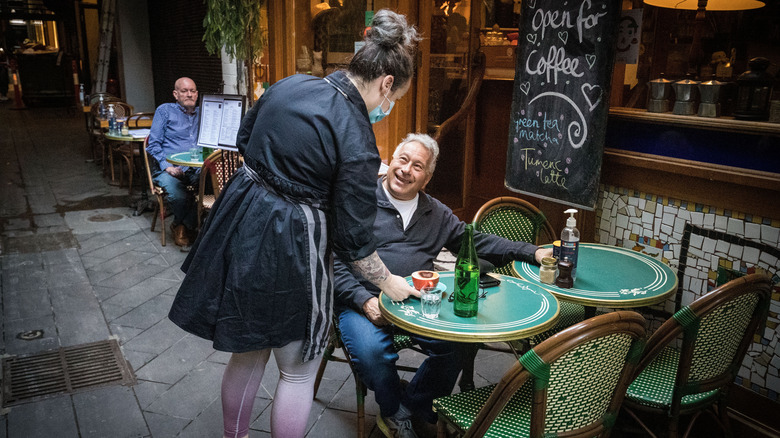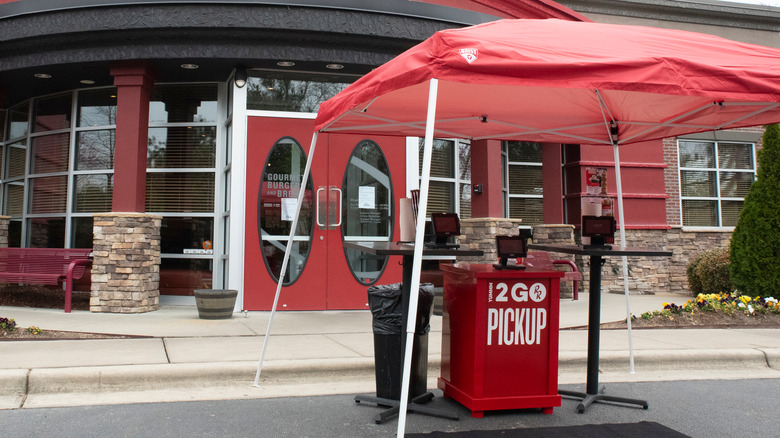These Big Changes May Be Coming To Restaurant Dining In 2022
The end of the year tends to signify new beginnings. Resolutions and goals, changes and improvements, a fresh calendar often makes people think of other ways they can get a little refresh in their lives. However, it's not just people who change when the clock strikes 12 on January 1, companies and industries frequently evolve too. And the restaurant industry is no different.
According to The Takeout, restaurants might look a little different in 2022. The article forecasts certain trends that might become more apparent in the next few months. While it might be easy to assume a lot of these changes will have to do with the ways COVID-19 has changed policies and procedures, the article argues modern tech will also drive a lot of change. "A whole host of other innovations are slowly but surely shifting the restaurant experience," the article explained.
If you're curious about what you can expect, keep reading for all the ways dining may evolve in 2022.
Expect changes in restaurant layouts
It's no surprise that the pandemic has ushered in a new need for consciously designed spaces. Six feet of separation is just a prerequisite now in most establishments, but don't expect it to change anytime soon. The Takeout predicts that private-forward dining isn't going away anytime soon. Expect to continue seeing spaced out tables, enclosed eating spaces, and QR code ordering systems for minimal contact between you, your server, and other patrons.
With that in mind, it's easy to understand why communal dining will also likely be phased out this coming year. In 2019, communal dining was an emerging trend as "a fun way to interact and make connections in a casual setting," (via OpenTable). While good intentions may have been there, it's not surprising diners won't be too eager to cozy up next to strangers anytime soon.
You can also expect to see more permanent and expansive outdoor eating spaces. In some of the more intense months of the pandemic, many states didn't even allow indoor dining (via USA Today), forcing restaurants to quickly readjust to an outdoor-only layout. "But since there was such a fast scramble to transform, there were many things to be desired," The TakeOut noted.
When restaurants had to quickly swap from indoor to outdoor dining, they didn't all have the necessary time to plan for every detail of the transformation. Now, it's predicted that with ample time, restaurants will put more focus toward their fresh air spaces for patrons to enjoy.
Restaurant protocols will also likely change
Aside from the way the restaurants actually look, The Takeout is also predicting changes in the way they operate. For one, expect to make more reservations in 2022, as walk-in dining may not be as accessible anymore. The Takeout noted that some of the reservation systems that were built in 2020 to plan for capacity limits stayed in place during 2021 because it helped owners and operators plan staffing needs. "With the ongoing staff shortage across the restaurant industry, it's reasonable to think that advance reservations will still be required for dining at a number of your favorite neighborhood spots," the article explained.
It's also likely that more restaurants will instate easier ways to grab your food and go, with more pickup areas and easier order-ahead options. Online ordering is growing 300% compared to dining in (via Fundera by NerdWallet), so it makes sense restaurants will want to create plenty of options to get your food easily and efficiently.
However, if you do like to eat in, don't count on finding a buffet in 2022. "With an overall desire for better sanitization and the fact that buffets usually have many people out of their seats and walking around near food, it's unlikely dining this way will continue," The Takeout wrote.
You may even start to see robots working while you're eating your favorite meal. Per The Takeout, large chains have already started testing ways robots could be integrated into procedures for an automated dining experience. With companies in need of workers, robots might become the answer (via Fortune).


